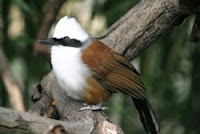
The white-crested laughing thrush, Garrulax leucolophus,(picture referenced from Wikipedia) is aptly named, and makes itself known by a cacophony of sounds that sound surprisingly like human laughter. In seeming harmony with its vocalizations, this bird is quite mischievous, at least in captivity.
Ranging from northern India to southwestern China, and south to Indonesia, this bird is an attractive chestnut-brown in color, with a brilliant white head and crest and a black band across the eyes. Although not often found in private collections in the US, a naturalist friend from India informed me that laughing thrushes are occasionally kept in his country, and make fine pets.
For years, I kept a group of four in a huge exhibit (Jungleworld) at the Bronx Zoo. The birds shared their home with a number of other creatures, and they seemed to delight in tormenting all of them! They would dive bomb the proboscis monkeys, and then sit tantalizingly close, but out of reach – “laughing”, it seemed, even harder than usual. Being quite intelligent themselves, the monkeys appeared genuinely frustrated, and never ceased their attempts to catch the feathered marauders. Slower moving animals, such as marsh crocodiles, were scolded and used as perching sites, and even such large birds as Indian hornbills moved away from the feeding area when “the gang” of thrushes arrived. If they did not, the ensuing racket convinced them of their error.
As they grew in confidence, the laughing thrushes became quite bold around people. They were extremely curious, and would go out of their way to get a better look at anything new, tilting their heads and raising their crests as they took it in. They recognized the sound of my keys, and flew in to accept small treats from my hand. Then one day a visitor dropped his keys and, in a flash, a thrush swooped down and made off with them. The tone of the bird’s laughter, according to the surprised visitor, was “mocking – no question about it”! The group’s greatest caper came soon after when, according to a cashier, one bird “distracted her” by perching a foot away and “babbling” while another flew in and stole the register key (and, of course, “laughed” derisively)! I can’t say that I doubt her – these outlaws do nest cooperatively, and so perhaps utilize team efforts in other ways as well.
Well, there is much more to say about these entertaining creatures – please write in with any questions. Parrots, crows, ravens and jays are also known as notorious rouges.
An article describing the breeding of this bird at the Riverbanks Zoo is available at:
www.riverbanks.org/subsite/pact/babblers.pdf
 That Bird Blog – Bird Care and History for Pet Birds
That Bird Blog – Bird Care and History for Pet Birds


